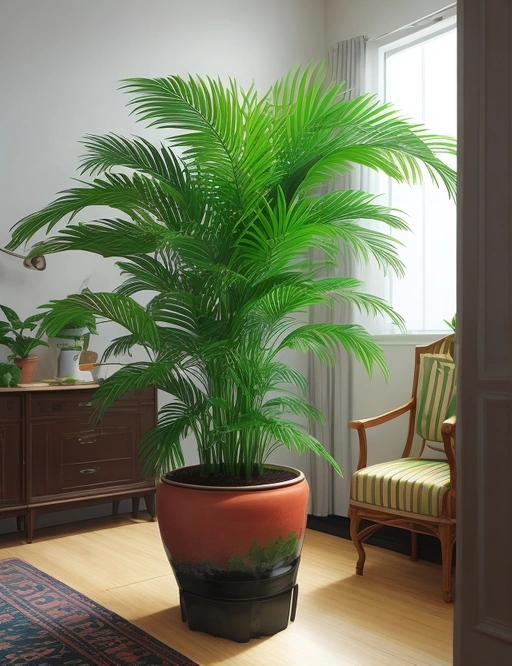Parlor Palm Care Guide: Essential Tips for Keeping Your Plant Thriving
Key Takeaways:
- Parlor palms thrive in bright, indirect light.
- Water parlor palms thoroughly but allow the top inch of soil to dry before watering again.
- Maintain moderate humidity levels for optimal parlor palm growth.
- Fertilize parlor palms every two to three months during the growing season.
Are you ready to become a green thumb guru? Look no further than this comprehensive guide to caring for your parlor palm.
With its lush, feather-like fronds, the parlor palm is the perfect companion to elevate the aesthetic of any room.
But how do you ensure it thrives in your care? I’ve got you covered.
From the ideal lighting conditions to watering tips and troubleshooting common problems, I’ll walk you through all the steps to keep your parlor palm healthy and happy.
So grab your gardening gloves and let’s dive into this parlor palm care guide!
| Aspect | Care Tips |
|---|---|
| Light | Place the plant in bright, indirect light. Avoid direct sunlight as it can scorch the leaves. |
| Temperature | Maintain a temperature between 60°F to 85°F (15°C to 29°C). Avoid exposure to drafts or extreme temperature fluctuations. |
| Watering | Keep the soil evenly moist, but not soaking wet. Water when the top inch of soil feels dry. Avoid overwatering or letting the plant sit in standing water. |
| Humidity | Parlor palms prefer moderate to high humidity. Use a humidifier or place the pot on a tray filled with water and pebbles to increase humidity. |
| Fertilization | Feed the plant with a balanced liquid fertilizer during the growing season (spring and summer) every 2-4 weeks. Avoid overfertilization, as it can damage the roots. |
| Pruning | Remove yellow or brown leaves regularly. Trim off any dead or damaged fronds to maintain the plant’s appearance. |
| Propagation | Propagate parlor palms from offsets or seeds. Offsets can be separated and planted in their own pots. Seeds usually take several months to germinate. |
| Pests | Watch out for common houseplant pests such as spider mites, mealybugs, and scales. Treat infestations with insecticidal soap or neem oil. |
Basic Care Tips for the Parlor Palm
For the best care of your Parlor Palm, focus on lighting, temperature/humidity, and watering/moisture requirements.
Light Requirements for the Parlor Palm
The Parlor Palm thrives in bright, indirect light.
Avoid direct sunlight as it can scorch the leaves.
It can tolerate lower light conditions, but growth may be slower.
Place it near a north or east-facing window, or provide artificial light if necessary.
Temperature and Humidity for the Parlor Palm
The Parlor Palm prefers temperatures between 65-80°F (18-27°C), so keep it in a warm spot away from drafts.
It also thrives in moderate to high humidity levels, so misting the leaves regularly or using a humidifier can help maintain its health.
Watering and Moisture Requirements for the Parlor Palm
Water the Parlor Palm when the top inch of soil feels dry to the touch. Be careful not to overwater, as it can lead to root rot.
Use room temperature water to keep the soil consistently moist, but never soggy.
Mist the leaves occasionally to increase humidity.

Potting and Repotting the Parlor Palm
For potting and repotting your Parlor Palm, it’s essential to choose the right pot and follow a step-by-step guide. I’ll also share signs that indicate your plant needs repotting.
Choosing the Right Pot for the Parlor Palm
Choosing the right pot for your Parlor Palm is important for its overall health and growth. Opt for a pot that is slightly larger than the current one, with good drainage holes.
Plastic or ceramic pots work well.
Avoid pots that are too big as they can hold excess moisture, leading to root rot.
Step-by-Step Guide to Repotting the Parlor Palm
To repot your Parlor Palm, start by choosing a pot that is slightly larger than the current one.
Remove the palm from its current pot and gently separate any entangled roots.
Place some fresh potting soil at the bottom of the new pot.
Carefully place the palm in the center and fill in the gaps with more soil.
Press the soil gently to secure the palm.
Water the palm thoroughly and allow excess water to drain.
Place the palm in a location with indirect sunlight.
Remember to provide regular care and monitor the plant for signs of stress or the need for repotting.
Signs That Your Parlor Palm Needs Repotting
If you notice any of these signs, it’s probably time to repot your parlor palm:
- Roots are growing out of the drainage holes.
- The pot is too small, causing the roots to become tightly packed.
- The plant is top-heavy and unstable.
- The soil doesn’t hold moisture or drains too quickly.
- The leaves are turning yellow or brown and the plant is struggling to grow.
- It has been more than 2-3 years since the last repotting.
Pruning and Grooming the Parlor Palm
To keep your Parlor Palm looking its best, regular pruning and grooming is important.
How to Prune and Trim the Parlor Palm
To prune and trim your Parlor Palm, start by identifying any brown or yellow leaves and carefully remove them using clean and sharp pruning shears. This will help to maintain the plant’s overall appearance and health.
Additionally, regularly grooming the plant by removing any dead or dry fronds will keep it looking tidy and prevent the accumulation of dust.
Just be sure to avoid cutting off too many healthy leaves, as this can harm the plant.

Removing Brown or Yellow Leaves from the Parlor Palm
To remove brown or yellow leaves from the Parlor Palm, I recommend using a pair of clean and sharp pruning shears or scissors. Gently cut the damaged leaf as close to the base as possible without damaging the healthy foliage.
Ensure that the blades are clean to prevent the spread of any potential diseases.
Regularly inspect your plant for any signs of discoloration and promptly remove any affected leaves to encourage healthy growth.

Grooming Tips to Maintain the Parlor Palm’s Shape
To maintain the shape of your Parlor Palm, regular grooming is essential.
Here are a few tips to help you out:
- Trim any overgrown or yellow leaves by cutting them close to the base. This will keep the plant looking tidy and prevent it from wasting energy on unhealthy foliage.
- Keep an eye out for any brown tips on the leaves and trim them off. This will improve the overall appearance of the plant and promote healthy growth.
- Remove any dead or dried fronds from the base of the plant. These can be gently pulled or cut off to maintain a neat and clean appearance.
- Dust the leaves regularly to keep them clean and prevent any build-up that may hinder the plant’s ability to photosynthesize efficiently.

Common Problems and Troubleshooting
Parlor palms may encounter common problems like overwatering, pests, and diseases.
Let’s troubleshoot these issues together!
Overwatering and Underwatering: Signs and Solutions
Overwatering signs: yellowing or wilting leaves, mushy or rotten roots. Solutions: adjust watering frequency, let soil dry out before watering again.
Underwatering signs: dry, brown, or crispy leaves, slow growth.
Solutions: increase watering frequency, check soil moisture, mist leaves, consider humidity tray.
Dealing with Pests on the Parlor Palm
Dealing with pests on the Parlor Palm can be a common issue.
Here are some simple steps you can take to tackle these pesky critters:
- Identify the pest: Look closely at the leaves and stems to determine which pest is causing damage. Common pests include spider mites, mealybugs, and scale insects.
- Remove the pests by hand: For smaller infestations, simply pick off the pests by hand and dispose of them. Be careful not to damage the plant in the process.
- Use insecticidal soap: If the infestation is more severe, you can spray the plant with insecticidal soap, making sure to cover both sides of the leaves. Follow the instructions on the product carefully.
- Introduce natural predators: Certain beneficial insects, like ladybugs or lacewings, can help control pests on your Parlor Palm. You can purchase them from garden centers or online.
- Quarantine affected plants: If you have multiple plants, it’s important to isolate the infested one to prevent the pests from spreading. Keep an eye on nearby plants for any signs of infestation.
By being proactive and taking swift action, you can effectively deal with pests on your Parlor Palm and keep your plant healthy and thriving.
Frequently Asked Questions about Parlor Palm Care
How fast does a Parlor Palm grow?
The Parlor Palm is a slow-growing plant, but it can eventually reach a height of about 4-6 feet.
It typically grows about 1-2 feet per year under ideal conditions.
Patience is key when caring for this plant, as it takes time to develop its full size and lush foliage.
Just remember to provide it with the right care and conditions, and it will eventually grow into a beautiful and thriving addition to your indoor space.
Can a Parlor Palm survive in low light conditions?
Yes, a Parlor Palm can survive in low light conditions! This plants can tolerate low to medium light levels, making them perfect for indoor spaces with limited natural light.
They’re great for offices, bedrooms, or any room that doesn’t receive direct sunlight.
Just make sure to keep them away from intense heat sources and they’ll thrive!
How often should I fertilize my Parlor Palm?
I recommend fertilizing your Parlor Palm once a month during the growing season, which is typically from spring to early fall.
Use a balanced, water-soluble houseplant fertilizer, and dilute it to half or quarter strength to avoid overfertilization.
Always follow the instructions on the fertilizer packaging for best results.
Final Verdict
Taking care of a Parlor Palm requires attention to its light, temperature, and watering needs. Providing adequate indirect sunlight, maintaining a temperature range of 60-85°F, and watering when the top inch of soil is dry are key to keeping this plant healthy.
Repotting should be done when the plant becomes root-bound, using the correct pot size and following a step-by-step guide.
Regular pruning and grooming will help maintain the Parlor Palm’s shape and removing brown or yellow leaves is important. Lastly, addressing overwatering, pests, and diseases promptly is crucial for the well-being of this plant.
Overall, by following these care tips, your Parlor Palm will thrive and bring beauty to your indoor space.







